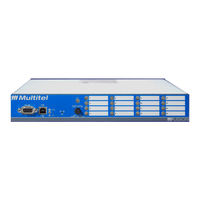Multitel Fusion Manuals
Manuals and User Guides for Multitel Fusion. We have 2 Multitel Fusion manuals available for free PDF download: User Manual
Multitel Fusion User Manual (241 pages)
Brand: Multitel
|
Category: Measuring Instruments
|
Size: 18 MB
Table of Contents
-
-
-
Analog Card23
-
Event Card23
-
Output Card23
-
-
-
-
-
Links79
-
-
-
-
-
Note File101
-
-
-
Groups (200)104
-
-
Callouts (32)115
-
Email Protocol117
-
Keepalive122
-
Views (32)131
-
Lead/Lag (4)139
-
-
-
-
SMX MODBUS Setup143
-
-
9 Communication
157-
Rear Rs-232 Port159
-
-
MODBUS Connector164
-
Modbus Modules165
-
-
NTP Protocol173
-
SNMP Protocol174
-
SNMP Trap175
-
SSH Protocol179
-
RADIUS Protocol180
-
SYSLOG Protocol182
-
-
Mechanical185
-
Electrical185
-
Environmental186
-
Modbus Modules190
-
Battery Backup192
-
-
11 Installation
193-
Mounting Fusion195
-
-
-
Fusion Start-Up220
-
12 Maintenance
222-
Calibration222
-
Troubleshooting228
-
-
13 Abbreviations
234 -
-
Network Address235
-
Ip Netmask236
-
16 Index
239
Advertisement
Multitel Fusion User Manual (48 pages)
EXPANSION SHELF

